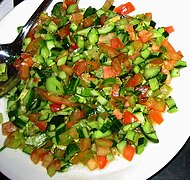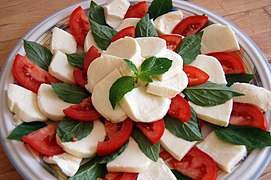Cookbook:Salad
| Salad | |
|---|---|
 |
Cookbook | Recipes | Ingredients | Equipment | Techniques | Cookbook Disambiguation Pages
Salads are generally a mixture of different individual foods—most commonly vegetable-based—bound with a dressing.[1] The term comes from the Latin word for salted, referring to the dressing.[2][3] They may be served prior to or after the main dish as a separate course, as a main course in itself, or as a side dish accompanying the main dish.
Types
[edit | edit source]Salads can be classified in a variety of ways, and many salads can fall into more than one type.
Green/garden salads
[edit | edit source]A very common variety of salad, green or tossed salads are made of green, leafy vegetables. Caesar salads are one common example. Other food items such as pasta, olives, cooked potatoes, rice, croutons, meat and poultry (e.g. bacon, chicken), cheese, nuts, or seafood (e.g. tuna, crab) are sometimes added to green salads. In modern times, green salads in particular are often served 'undressed', and a separate salad dressing, often of the eater's choosing, will be served with or alongside the salad.
Vegetable salads
[edit | edit source]Vegetable salads are made primarily of non-leafy greens.[4] They can be cooked or raw, and are often marinated.[5] For example, Cucumber, Tomato, and Onion Salad, in which sliced or diced cucumber, tomato and onion are served anywhere from being merely dressed with, to literally floating in, a water and vinegar mixture, with, perhaps, a bit of black pepper, salt and herbs added. An example of a vegetable medley salad is Three Bean Salad, which, in a typical recipe, is composed primarily of green beans, wax beans, and kidney beans, all of which are often canned, in a somewhat clear, or sweet, vinegar-based dressing.
Composed salads
[edit | edit source]Composed salads are not mixed, but instead arranged artfully in the serving dish.[6][4]
Gelatin salads
[edit | edit source]Gelatin salads consist of solid components (e.g. vegetables, fruits, meats) suspended in a sweet or savory jelly that has been shaped in a decorative mold.[5]
Fruit salads
[edit | edit source]A fruit salad is a sweet salad made of bite-sized pieces of culinary fruits (i.e. not those like tomatoes). It can be dressed with liqueurs, sweeteners, yogurt, jam, or fruit purées.[5] From there, fruit salads can quickly branch out to be, in essence, desserts, such as ambrosia.
Bound salads
[edit | edit source]Bound salads have thick dressings that bind the ingredients together. Common bound salads include chicken/tuna salad, egg salad, pasta salad, and potato salad.[4] For use in a more elegant setting, such salads may be served on a bed of greens and can include more elegant ingredients, if desired.
Slaws
[edit | edit source]Slaws, which are typically composed primarily of finely chopped or julienned fresh vegetables of a sturdy sort (such as cabbages, carrots, broccoli, etc.), perhaps the most commonly known of which is coleslaw. Coleslaw, in particular, is primarily composed of cabbage coated in a simple dressing prepared and added by the cook before serving. The dressing, in some areas of the world, is typically mayonnaise-based, but may also be vinegar-and-water based. It is served cold to room temperature, without any additional dressing expected to be applied by the eater.
Noodle salads
[edit | edit source]These include, for example, cold cellophane noodles or rice vermicelli and a variety of fresh diced or julienned vegetables with an appropriate dressing. They are served cold or at room temperature. The noodles mentioned are fragile so care must be taken to only cook them briefly and immediately chill them quickly and thoroughly in cold water before attempting to use them in a salad.
Components
[edit | edit source]Vegetables
[edit | edit source]A variety of leafy greens can be used in tossed salads, ranging from mild to spicy, and the specific blend characterizes the salad.[7] They should be tender and delicate enough to be eaten raw.[7] Mild greens include spinach, lettuce, and watercress.[8] Spicy greens have a peppery kick and can include things like arugula. Micro-greens include a variety of sprouted seedlings and are typically mild in flavor.[7] Commercial salad blends can be commonly purchased.[7]
Other common vegetables in a green salad include tomato, cucumber, peppers, mushroom, onion, spring onion, carrot and radish.

Dressing
[edit | edit source]Dressing is a flavorful liquid mixed into a salad for a variety of purposes, including taste, spice, and moisture.[9]
Garnish
[edit | edit source]Garnishes can be added to a salad for flavor, texture, and visual flair.[9] Fresh, delicate herbs (e.g. mint, basil, chives, parsley) are often good choices.[7] Crisp garnishes such as croutons, crackers, etc, add contrast and texture.[7] Edible flowers can elevate a salad and make it quite beautiful.[7]
Techniques
[edit | edit source]
Washing
[edit | edit source]As with all foods, the ingredients of a salad should be as fresh as possible, without blemish. The components should be well-cleaned, and greens should be specially looked over to remove any dirt.[10][11] They then need to be well-dried so that the dressing sticks and imparts flavor.[10]
Cutting
[edit | edit source]The ingredients of a salad are expected to be cut by the cook to a size that will fit in the human mouth, such that no cutlery is required, except in a very few cases where the need for cutting by the eater is quite apparent and knives are provided. Salads, in general, are intended to be eaten using a fork or chopsticks, rather than by spoon or by hand. Accordingly, medium-small, round ingredients, for example, cherry tomatoes, grapes, olives, and items of a similar size, should be cut at least in half; otherwise they will be difficult to lift with the intended utensils.
Dressing
[edit | edit source]Dressings are essentially seasoning and should just highlight the salad.[12] Typically you don't want to add so much that it pools.[13] Acidic dressings should only be added to most salads at the last minute, since they will make greens wilt and will toughen some ingredients like beans.[14][13]
Gallery
[edit | edit source]-
Potato salad
-
Caesar salad
-
Tabbouleh
-
Fruit salad
-
Pasta salad
-
"Israeli" salad
-
Caprese salad
-
Egg salad
-
Seaweed salad
-
Sweet jelly salad
Recipes
[edit | edit source]References
[edit | edit source]- ↑ Labensky, Sarah R.; Hause, Alan M.; Martel, Priscilla (2018-01-18). On Cooking: A Textbook of Culinary Fundamentals. Pearson. ISBN 978-0-13-444190-0.
- ↑ America (CIA), The Culinary Institute of (2012-04-16). Garde Manger: The Art and Craft of the Cold Kitchen. John Wiley & Sons. ISBN 978-0-470-58780-5.
- ↑ Davidson, Alan (2014-01-01). Jaine, Tom (ed.). The Oxford Companion to Food. Oxford University Press. doi:10.1093/acref/9780199677337.001.0001. ISBN 978-0-19-967733-7.
- ↑ a b c Gisslen, Wayne (2015-03-12). Essentials of Professional Cooking, 2nd Edition. Wiley Global Education. ISBN 978-1-119-03072-0.
- ↑ a b c Labensky, Sarah R.; Hause, Alan M.; Martel, Priscilla (2018-01-18). On Cooking: A Textbook of Culinary Fundamentals. Pearson. ISBN 978-0-13-444190-0.
- ↑ America (CIA), The Culinary Institute of (2012-04-16). Garde Manger: The Art and Craft of the Cold Kitchen. John Wiley & Sons. ISBN 978-0-470-58780-5.
- ↑ a b c d e f g America (CIA), The Culinary Institute of (2012-04-16). Garde Manger: The Art and Craft of the Cold Kitchen. John Wiley & Sons. ISBN 978-0-470-58780-5.
- ↑ Labensky, Sarah R.; Hause, Alan M.; Martel, Priscilla (2018-01-18). On Cooking: A Textbook of Culinary Fundamentals. Pearson. ISBN 978-0-13-444190-0.
- ↑ a b Gisslen, Wayne (2015-03-12). Essentials of Professional Cooking, 2nd Edition. Wiley Global Education. ISBN 978-1-119-03072-0.
- ↑ a b America (CIA), The Culinary Institute of (2012-04-16). Garde Manger: The Art and Craft of the Cold Kitchen. John Wiley & Sons. ISBN 978-0-470-58780-5.
- ↑ The Culinary Institute of America (CIA) (2011-09-13). The Professional Chef. John Wiley & Sons. ISBN 978-0-470-42135-2.
- ↑ Gisslen, Wayne (2015-03-12). Essentials of Professional Cooking, 2nd Edition. Wiley Global Education. ISBN 978-1-119-03072-0.
- ↑ a b America (CIA), The Culinary Institute of (2012-04-16). Garde Manger: The Art and Craft of the Cold Kitchen. John Wiley & Sons. ISBN 978-0-470-58780-5.
- ↑ Labensky, Sarah R.; Hause, Alan M.; Martel, Priscilla (2018-01-18). On Cooking: A Textbook of Culinary Fundamentals. Pearson. ISBN 978-0-13-444190-0.









